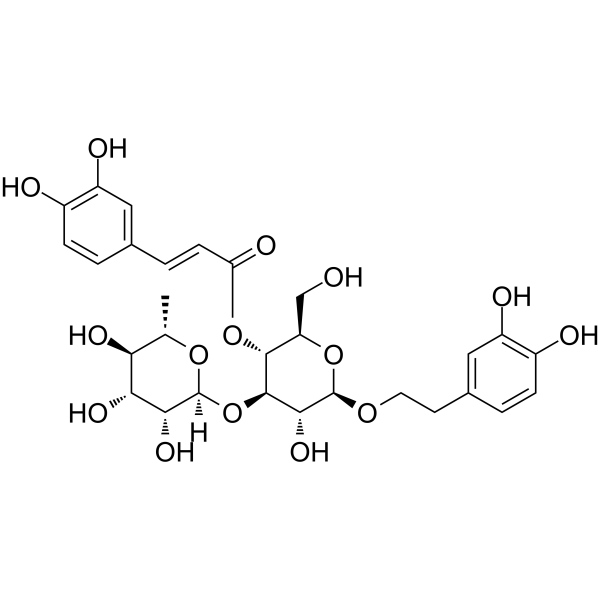
Acteoside is isolated from Acanthus mollis, acts as an ATP-competitive inhibitor of PKC, with an IC50 of 25 µM, and has antitumor, anti-inflammatory and antineuropathic pain activity. Acteoside has potent antitumor activity against L-1210 cells, with an IC50 of 13 µM. Acteoside (5, 10 µM) suppresses 2,4-dinitrochlorobenzene (DNCB)-induced T cell costimulatory factors CD86 and CD54, proinflammatory cytokines, and NFκB pathway activation in THP-1 cells.
| Molecular Weight | 624.59 |
| Formula | C29H36O15 |
| CAS Number | 61276-17-3 |
| Solubility (25°C) | DMSO ≥ 60 mg/mL Water ≥ 60 mg/mL |
| Storage |
Powder -20°C 3 years ; 4°C 2 years In solvent -80°C 6 months ; -20°C 1 month |
| Species | Mouse | Rat | Rabbit | Guinea pig | Hamster | Dog |
| Weight (kg) | 0.02 | 0.15 | 1.8 | 0.4 | 0.08 | 10 |
| Body Surface Area (m2) | 0.007 | 0.025 | 0.15 | 0.05 | 0.02 | 0.5 |
| Km factor | 3 | 6 | 12 | 8 | 5 | 20 |
| Animal A (mg/kg) = Animal B (mg/kg) multiplied by | Animal B Km |
| Animal A Km |
For example, to modify the dose of Compound A used for a mouse (20 mg/kg) to a dose based on the BSA for a rat, multiply 20 mg/kg by the Km factor for a mouse and then divide by the Km factor for a rat. This calculation results in a rat equivalent dose for Compound A of 10 mg/kg.
| Related PKC Products |
|---|
| PKC β pseudosubstrate
PKC β pseudosubstrate is a selective cell-permeable inhibitor of PKC. |
| Protein Kinase C (19-31)
Protein Kinase C (19-31), a peptide inhibitor of protein kinase C (PKC), is used as protein kinase C substrate peptide for testing the protein kinase C activity. |
| Protein Kinase C (19-36)
Protein Kinase C (19-36) is a pseudosubstrate peptide inhibitor of protein kinase C (PKC), with an IC50 of 0.18 μM. |
| [Ala113]MBP(104-118)
[Ala113]MBP(104-118) is an noncompetitive peptide inhibitors of protein kinase C (PKC), with IC50s ranging from 28-62 μM. |
| [Ala107]MBP(104-118)
[Ala107]MBP(104-118) is an noncompetitive peptide inhibitors of protein kinase C (PKC), with IC50s ranging from 46-145 μM. |


Products are for research use only. Not for human use. We do not sell to patients.
© Copyright 2010-2023 AbMole BioScience. All Rights Reserved.
